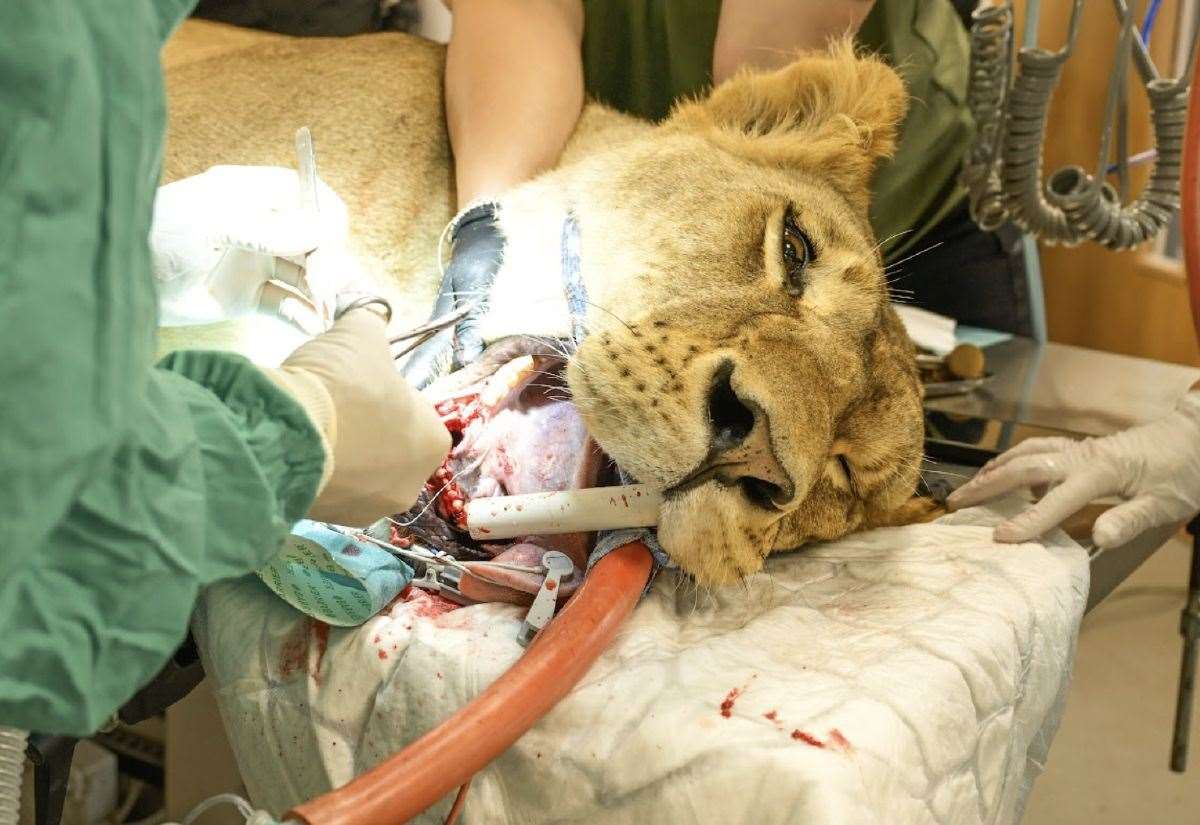A lioness rescued from war-torn Ukraine has undergone a huge operation lasting almost three hours.
Lira, a three-year-old living at The Big Cat Sanctuary in Smarden, near Ashford, arrived at the park in March following the country’s ongoing conflict with Russia.
Lira underwent a two-and-a-half dental operation. Picture: The Big Cat Sanctuary
Rescued alongside her sister, Amani, and fellow lions Amani, Rori, Vanda and Yuna, she was assumed to be illegally bred for photo exploitation purposes.
However, Lira hasn’t just suffered emotional damage.
A tooth infection sustained when she was between 18 months and two years old has forced her to go under the knife to remove it.
Keepers say it was necessary to remove the severely infected lower right canine tooth as the trauma was caused by a deep-seated abscess.
It led to the 140kg animal being immobilised by vets using a dart gun loaded with a quick-acting anaesthetic combination.
The complex surgery was then performed by dentist Peter Kertesz from Zoodent International, who has treated about 450 big cats globally.
Lira (left) and her sister Amani. Picture: The Big Cat Sanctuary
Mr Kertesz says the infection was leading to bacteria producing toxins inside the tooth.
He said: “When I examined Lira’s jaw and mouth, I could see immediately the broken tooth was severely infected.
“My philosophy is non-human dental problems need to be treated in the most predictable, the least invasive and safest way.
“Lira doesn’t have to catch prey, so in this case, extraction was the most sensible and ethical solution.
“If it had been a less severe infection, I would have filled it.”
The extracted tooth measured a formidable 8cm in length.
Mr Kertesz drained a pocket of pus from beneath the tooth and closed the large wound with seven dissolving sutures.
He also performed a root canal treatment on the opposing upper canine tooth, which was found to be infected, cleaning and filling it with materials virtually identical to those used for human patients.
Lira was later transported back to her home while still sedated, where the anaesthetic was reversed to allow her to wake up safely under the care of the veterinary team.
The sanctuary’s curator, Briony Smith, added: “We had noticed a small lump on Lira’s jawline, but it is impossible for us to know the extent of the problem in situations like this.
“I am so glad we booked her in as it was a much bigger issue than any of us had anticipated.
“The procedure was a complete success. Lira will be a little uncomfortable to begin with, but now the toxins are out of her body she will start to feel much better over the coming days.”
Lira arrived at her new Kent home in March from Ukraine. Picture: The Big Cat Sanctuary
Lira arrived at the park following the park’s ‘Big Cats in Crisis’ campaign, which saw the charity raise £500,000 for her and four other rescued lions to make Kent their new home from Ukraine.
All four cats had been in temporary facilities across Belgium called Pairi Daiza, Planckendael Zoo and Natuur Hulp Centrum.
Work on a new enclosure, called The Lion Rescue Centre, began in July 2024, opening on March 25 this year.
The purpose-built facility has been designed to meet the four new cats’ and Yuna’s physical and psychological needs, ensuring a secure and stimulating space for their future.
